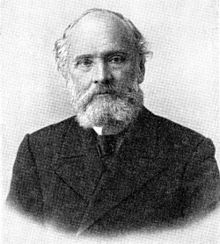Andrei Sergeevich Faminzyn
Andrei Sergeyevich Faminzyn even Faminzin , Famintsyn or Famintzin ( Russian Андрей Сергеевич Фаминцын ; June 17 . Jul / 29. June 1835 greg. In Sokolniki in Moscow, † 8. December 1918 in Petrograd ) was a Russian biologist and plant physiologist.
Life
Faminzyn studied science from 1853 to 1857 at the University of Saint Petersburg . Even during his studies, he was particularly interested in the physiology of lower plant species, which is why, after completing his studies, he visited the specialists in this field researching Gustave Thuret in Antibes on the Mediterranean and Anton de Bary in Freiburg im Breisgau to deepen his knowledge in this area. He acquired the latest methods for determining analytical and physiological chemistry from Bunsen and Kirchhoff in Heidelberg and Lambert von Babo also from Freiburg im Breisgau.
Back in St. Petersburg in 1861, Famintsyn taught at the university's botanical chair, initially as a master's degree, from 1863 as a lecturer and doctor of botany, and finally from 1867 as a professor of plant anatomy and plant physiology . In parallel to his lectures, he undertook culture experiments with isolated lichen seeds, with which he was able to successfully demonstrate that they were suitable as symbiotic forms of life as partners for algae and chloroplastida .
Associated with the Academy of Sciences since 1878 as an adjunct and in 1884 as an associate member , Famintsyn founded the renowned cabinet for anatomy and physiology of plants at the academy in 1890 , since he had left St. Petersburg in protest in 1889 because of the introduction of a police regime. As chairman and full member of the academy, he headed this institute from 1901 until his death.
This upheaval in his life did not prevent Faminzyn from interrupting his research. With his experiments with zoochlorella and with plastids of green plants in the 1890s, he developed a new theory of evolution with evidence of a higher development through symbiogenesis . Another focus of his research was the study of photosynthesis and metabolism in plants and demonstrated the carbon dioxide assimilation of starch formation even with artificial lighting.
With its experiments, textbooks and laboratories, not only Russia owes significant contributions to plant physiology and microbiology, but also the entire scientific floristry in other countries. To this end, influential scientists such as Ivan P. Borodin, Dmitri Iossifowitsch Iwanowski , Dmitrij N. Neljubow, Kliment Arkadjewitsch Timirjasew , Michail Zwet , Sergei Nikolajewitsch Winogradski and others emerged from the school of Faminzyn .
His younger brother is the composer Alexander Sergejewitsch Faminzyn (* 1841).
Publications
- The effect of light on the greening of plants ; St. Petersburg, 1855
- On the history of the development of the gonidia and zoospore formation in lichens (in conjunction with Voranetzky, Petersburg 1867)
- Contribution to the doctrine of cotyledons in the plant kingdom ; ibid. 1876
- Embryological studies ; ibid. 1879
- Studies on Crystals and Crystallites ; ibid. 1884
- Contribution to the symbiosis of algae and animals ; ibid. 1889
- Overview of the achievements in the field of botany in Russia during 1.1890 / 91 ; German, Petersburg, 1892/93
- Investigations into the ripening of grapes
Web links
- Literature by and about Andrei Sergejewitsch Faminzyn in the bibliographic database WorldCat
Individual evidence
- ↑ retrobibliothek.de
- ↑ a b c d e Ekkehard Höxtermann: Faminzyn, Andrei Sergejewitsch , Lexicon of important natural scientists, 2007, Volume 2; P. 3, Elsevier GmbH, Munich; ISBN 3-8274-1883-6
- ↑ Studies on plant respiration. Abh. 1. (Leipzig Voss Riga Kymmel St. Petersburg Eggers 1881) WorldCat, accessed on February 23, 2020 .
- ↑ Nelyubov Dmitri. Retrieved February 23, 2020 .
| personal data | |
|---|---|
| SURNAME | Faminzyn, Andrei Sergejewitsch |
| ALTERNATIVE NAMES | Фаминцын, Андрей Сергеевич (Russian spelling) |
| BRIEF DESCRIPTION | Russian biologist and plant physiologist |
| DATE OF BIRTH | June 29, 1835 |
| PLACE OF BIRTH | Sokolniki |
| DATE OF DEATH | December 8, 1918 |
| Place of death | Petrograd |
